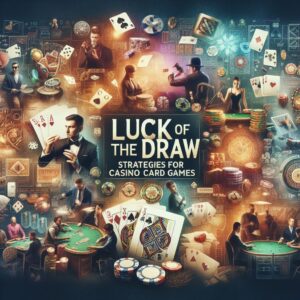
Casinos are not merely places where individuals test their luck against the odds; they are meticulously designed environments that seek to influence player behavior in subtle yet powerful ways. The layout, architecture, lighting, and even the colors chosen for casino interiors are all elements carefully crafted to create an immersive and captivating experience. In this article, we unravel the intricate dance between casino design and player behavior, exploring how the physical environment plays a crucial role in shaping the way patrons engage with the world of gambling.
The Power of Design: Beyond Aesthetics
Casino design is a multidimensional art that extends far beyond mere aesthetics. Every element of the casino environment is intentionally crafted to evoke specific emotions, encourage certain behaviors, and create an atmosphere that keeps players engaged and entertained. From the moment patrons step through the entrance to the layout of gaming floors and the placement of slot machines, every detail is strategically considered.
1. Layout and Traffic Flow: Guiding the Experience
The layout of a casino is a crucial component in influencing player behavior. Casinos are often designed with winding, maze-like paths that guide players through various gaming areas. This intentional design serves multiple purposes, including maximizing exposure to different games and creating a sense of exploration. The deliberate lack of clocks and windows further disorients players, making it challenging for them to track time and enhancing the immersive experience.
2. Slot Machine Placement: A Strategic Approach
Slot machines, the backbone of many casinos, are strategically placed to optimize player engagement. High-traffic areas, entrances, and near popular amenities like restaurants and bars are prime locations for slot machines. The “clustering” of machines, where multiple slots are grouped together, creates a vibrant and dynamic atmosphere, encouraging players to stay longer and continue playing.
3. Lighting and Color Psychology: Setting the Mood
The use of lighting and color in casino design is a sophisticated tool to influence mood and behavior. Warm, subdued lighting creates a cozy and inviting ambiance, while vibrant colors are strategically employed to evoke excitement and energy. The juxtaposition of bright lights and contrasting colors on slot machines draws attention and creates a visually stimulating environment, enhancing the overall sensory experience.
4. Soundscapes: The Rhythm of Entertainment
Sound plays a crucial role in shaping the atmosphere within a casino. The constant hum of activity, the chime of slot machines, and the occasional jingle of a jackpot create a dynamic soundscape that contributes to the overall energy. Casinos often use carefully curated playlists to maintain a lively and entertaining atmosphere, subtly encouraging players to stay engaged and immersed in the gaming experience.
5. Architectural Design: Building an Identity
The architecture of a casino is not just about providing shelter; it is about creating a distinctive identity. Iconic structures and unique architectural elements help casinos stand out and become landmarks in their own right. The grandeur of architectural design contributes to a sense of luxury and opulence, attracting patrons and conveying a message of exclusivity and sophistication.
See Also:



Psychological Triggers: Tapping into Cognitive Patterns
Beyond the physical elements of design, casinos leverage psychological triggers to influence player behavior. Understanding cognitive patterns and behavioral psychology allows designers to create environments that subtly nudge individuals towards desired actions, such as prolonged play, increased betting, or more frequent returns to the casino.
1. Near Misses and Reward Systems: A Psychological Quirk
Slot machines are notorious for incorporating near misses into their design, creating the illusion that a player almost won. This psychological quirk triggers the brain’s reward system, leading players to believe that success is just around the corner. The anticipation generated by near misses can encourage players to keep trying their luck, fostering longer play sessions.
2. Variable Reward Schedules: Keeping It Unpredictable
Variable reward schedules, inspired by behavioral psychology principles, are often employed in casino game design. Slot machines, for example, use random number generators to create unpredictable outcomes. The uncertainty and variability of rewards heighten the excitement and anticipation, contributing to a more engaging and addictive experience.
3. Social Facilitation: Creating a Social Atmosphere
Casino design often incorporates elements that encourage social interaction. The placement of communal gaming tables, bars, and entertainment venues fosters a social atmosphere, where individuals feel encouraged to join in the collective experience. Social facilitation can enhance the enjoyment of the casino environment and contribute to longer stays.
Ethical Considerations: Balancing Entertainment and Responsibility
While the strategic design of casinos is intended to create an immersive and enjoyable experience, ethical considerations arise regarding the potential impact on vulnerable individuals. The deliberate use of psychological triggers to promote longer play sessions and increased betting may contribute to problematic gambling behavior, addiction, and financial harm.
Responsible casino operators recognize the ethical implications of their design choices and actively implement measures to promote responsible gambling. This includes providing information on responsible gaming, offering self-exclusion programs, and ensuring that employees are trained to identify and assist individuals exhibiting signs of gambling-related issues.
Conclusion: Casino Design and Player Behavior
The link between casino design and player behavior is a dynamic and ongoing dance, shaped by the interplay of aesthetics, psychology, and the pursuit of entertainment. While casinos aim to create engaging environments that keep patrons entertained and coming back, the ethical responsibility to safeguard player well-being remains paramount.
As the design of casinos evolves with technological advancements and changing societal attitudes, the industry faces an ongoing challenge to strike a balance between creating immersive experiences and promoting responsible gambling. The intricate dance between casino design and player behavior continues to unfold, influenced by a complex interplay of art, science, and ethical considerations in the ever-evolving world of gaming and entertainment.







